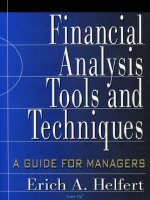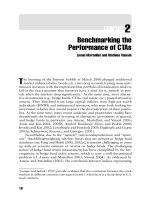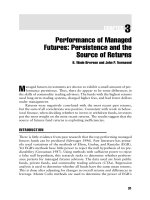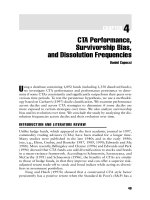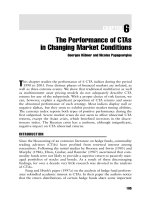Commodity Trading Advisors: Risk, Performance Analysis, and Selection Chapter 2 pptx
Bạn đang xem bản rút gọn của tài liệu. Xem và tải ngay bản đầy đủ của tài liệu tại đây (196.52 KB, 13 trang )
18
CHAPTER
2
Benchmarking the
Performance of CTAs
Lionel Martellini and Mathieu Vaissié
T
he bursting of the Internet bubble in March 2000 plunged traditional
market indices (stocks, bonds, etc.) into deep turmoil, leaving most insti-
tutional investors with the impression that portfolio diversification tends to
fail at the exact moment that investors have a need for it, namely in peri-
ods when the markets drop significantly.
1
At the same time, most alterna-
tive investments (e.g., hedge funds, CTAs, real estate, etc.) posted attractive
returns. They benefited from large capital inflows from high-net-worth
individuals (HNWI) and institutional investors, who were both looking for
investment vehicles that would improve the diversification of their portfo-
lios. At the same time, many recent academic and practitioner studies have
documented the benefits of investing in alternative investments in general,
and hedge funds in particular (see Amenc, Martellini, and Vaissié 2003;
Amin and Kat 2002, 2003b; Anjilvel Boudreau, Urias, and Peskin 2000;
Brooks and Kat 2002; Cerrahoglu and Pancholi 2003; Daglioglu and Gupta
2003a; Schneeweis, Karavas, and Georgiev 2003).
Nevertheless, due to the “natural” (survivorship/selection) and “spuri-
ous” (backfilling/weighting scheme) biases that are present in hedge fund
databases (see Fung and Hsieh 2000, 2002a), it remains challenging to come
up with an accurate estimate of returns on hedge funds. The challenging
nature of hedge fund return measurement has been exemplified by the het-
erogeneity in hedge fund index returns, which is now a well-documented
problem (cf. Amenc and Martellini 2003; Vaissié 2004). As evidenced by
Amenc and Martellini (2003), the correlation between indices representing
1
Longin and Solnik (1995) provide evidence that the correlation between the stock
markets in different countries converges toward 1 when there is a sharp drop in U.S.
stock markets.
c02_gregoriou.qxd 7/27/04 11:00 AM Page 18
Benchmarking the Performance of CTAs 19
the same investment style may turn out to be as low as 0.43 for equity mar-
ket neutral or 0.46 for equity long short. This fact may leave investors with
a somewhat confused picture of the performance of alternative investment
strategies. More surprisingly perhaps, index heterogeneity also may be of
concern in the case of CTAs. Dealing with CTA index heterogeneity is dis-
cussed in the next sections. It is crucial for investors to pay particular atten-
tion to the selection of an appropriate index to benchmark their performance
and to assess their exposure to risk factors. To respond to investors’ expec-
tations, in this chapter we present an original methodology to construct a
pure and representative CTA index (also known as the Edhec CTA Global
Index; hereafter referred to as the Edhec CTA Index). We then use the
Edhec CTA Index to analyze CTA return characteristics and the extent to
which investors would be better off integrating CTAs in their global alloca-
tion. Finally, we derive a five-factor model to identify the underlying risk
factors driving CTA performance.
DEALING WITH CTA INDEX HETEROGENEITY
Because managed futures tend to trade more liquid assets than hedge funds
and because they have to register with the Commodity Futures Trading
Commission (CFTC), one would expect the different managed futures
indices to exhibit negligible heterogeneity. This, however, is not the case.
While the average correlation between the different indices available on the
market
2
from January 1998 through September 2003 is 0.94, the difference
between the monthly returns on two of these indices can be as high as 7.50
percent, the return difference between the S&P Index (+13.50 percent) and
the Barclay CTA Index in December 2000. The corresponding average
monthly difference amounts to 2.90 percent. This gives clear evidence that
managed futures indices are not free from “natural” and/or “spurious”
biases. As evidenced in Posthuma and Van der Sluis (2003), the backfilling
bias is even higher for commodity trading advisers (CTAs) than for hedge
funds (3.30 percent versus 2.23 percent). Liang (2003), perhaps surpris-
ingly, drew the same conclusion with respect to survivorship bias, which
turns out to be significantly higher in the case of CTAs (5.85 percent versus
2.32 percent).
Table 2.1 illustrates the consequences of the heterogeneity of index con-
struction methodologies and fund selection in terms of risk factor expo-
2
For example, CSFB/Tremont Managed Futures Index, the CISDM Trading Advisor
Qualified Universe Index, the HF Net CTA/Managed Futures Average, the Barclay
CTA Index, and the S&P Managed Futures Index.
c02_gregoriou.qxd 7/27/04 11:00 AM Page 19
20 PERFORMANCE
sures. To come up with a limited set of risk factors, we selected 16 factors
known to be related to the strategies implemented by managed futures,
namely stocks, bonds, interest rates, currency, and commodities factors. We
then used stepwise regression with the backward entry procedure to avoid
any multicollinearity problems and keep a sufficient number of degrees of
freedom. While four factors are common to all indices (Lehman Global U.S.
Treasury, U.S. dollar [USD] versus major currency, USD versus Japanese
yen, and Goldman Sachs Commodity Index [GSCI], the corresponding
exposures turn out to be very different. The S&P index yields a beta of 1.49
with the Lehman Global U.S. Treasury while the beta is 0.67 for the Bar-
clay index. In the same vein, the CSFB index has a −0.69 beta with the USD
versus major currency while the beta is 0.18 for the Barclay index. Only
two indices (CSFB and HF Net) appear to exhibit significant exposure to
the S&P 500 and only one (HF Net) to the evolution of the VIX (implied
volatility on the S&P 500).
Since the choice of index may have a significant impact on the whole
investment process (from strategic allocation through performance evalua-
TABLE 2.1 The Heterogeneity of CTA Indices’ Risk Factor Exposure,
September 1999 to September 2003
Risk Factors CSFB S&P Barclay HF Net CISDM
Constant 4.52E−03 6.78E−03 2.93E−03 8.04E−03 4.27E−03
T-stats 1.1 1.1 1.0 2.5 1.5
S&P 500 −0.21 −0.09
T-stats −2.8 −1.3
LEHMAN GLB. 0.89 1.49 0.67 0.76 0.71
US TREASURY
T-stats 2.9 3.6 3.3 3.3 3.5
LEHMAN HIGH −0.39 −0.13 −0.21 −0.12
YIELD CORP
T-stats −2.0 −1.4 −1.7 −1.3
US $ MAJOR −0.69 −0.54 0.18 −0.46 −0.44
CURRENCY
T-stats −2.2 −1.2 1.7 −2.0 −2.1
US $ TO JAPANESE −0.54 −0.55 −0.20 −0.40 −0.39
YEN
T-stats −2.8 −2.0 −1.9 −2.7 −2.9
Goldman Sachs 0.21 0.26 0.14 0.16 0.13
Commodity Index
T-stats 3.3 2.7 3.0 3.2 2.8
Chg in VIX −0.03
T-stats −1.4
c02_gregoriou.qxd 7/27/04 11:00 AM Page 20
Benchmarking the Performance of CTAs 21
tion and attribution), investors should be aware of and tackle those differ-
ences in factor exposures. In what follows, we present an index construc-
tion methodology aimed at addressing this issue. Note that this methodology
was first introduced in Amenc and Martellini (2003) and is now imple-
mented to construct the Edhec Alternative Indices.
3
Given that it is impossible to be objective on what is the best existing
index, a natural idea consists of using some combination of competing
indices (i.e., CTA indices available on the market) to extract any common
information they might share. One straightforward method would involve
computing an equally weighted portfolio of all competing indices. Because
competing indices are based on different sets of CTAs, the resulting port-
folio of indices would be more exhaustive than any of the competing indices
it is extracted from. We push the logic one step further and suggest using
factor analysis to generate a set of hedge fund indices that are the best pos-
sible one-dimensional summaries of information conveyed by competing
indices for a given style, in the sense of the largest fraction of variance
explained. Technically speaking, this amounts to using the first component
of a Principal Component Analysis of competing indices. The Edhec CTA
Index is thus able to capture a very large fraction of the information con-
tained in the competing indices.
On one hand, the Edhec CTA Index generated as the first component
in a factor analysis has a built-in element of optimality, since there is no
other linear combination of competing indices that implies a lower infor-
mation loss. On the other hand, since competing indices are affected differ-
ently by measurement biases, searching for the linear combination of
competing indices that implies a maximization of the variance explained
leads implicitly to a minimization of the bias. As a result, the Edhec CTA
Index tends to be very stable over time and easily replicable.
CTA PERFORMANCE AT A GLANCE
Table 2.2 gives a comparative overview of the Edhec CTA Index, the S&P
500, and the Lehman Global Bond Index. Due to an average return that is
slightly superior to the S&P 500 (0.73 percent versus 0.50 percent) and
variance that is close to that of the Lehman Global Bond Index (0.84 per-
cent versus 0.14 percent), the Edhec CTA Index obtains a Sharpe ratio that
is significantly higher than stock and bond indices (0.72 versus 0.21 and
−0.39, respectively). Its superiority in terms of risk-adjusted performance is
even more marked when considering the Sortino ratio (11.01 versus 1.05
3
Further details on the construction methodology of the Edhec Alternative Indices
may be found at www.edhec-risk.com.
c02_gregoriou.qxd 7/27/04 11:00 AM Page 21
4
cf. Favre and Galeano (2002b) for more details on the Modified VaR and its
application to hedge funds.
22 PERFORMANCE
and −8.11) due to a limited downside risk (i.e., 0.49 percent versus 1.85
percent for the S&P 500). The Edhec CTA Index posts positive returns in
about 57 percent of months, with an average gain of 2.52 percent versus an
average loss of −1.62 percent in 43 percent of the cases. It is also worth not-
ing that the Edhec index presents a smaller maximum uninterrupted loss
than both the stock and bond indices.
Concerning extreme risks, the Edhec CTA Index is closer to the bond
index than to the stock index with a modified value at risk (VaR) (also
referred to as Cornish Fisher VaR
4
) of −6.52 percent as opposed to −13.49
TABLE 2.2 Basic Statistical Properties of the Edhec CTA Global Index,
January 1997 to September 2003
Edhec CTA Lehman Global
Global Index S&P 500 Bond Index
Monthly Average Return 0.73% 0.50% 0.06%
Monthly Median Return 0.65% 0.76% 0.12%
Monthly Max. Return 6.91% 9.67% 2.15%
Monthly Min. Return −5.43% −14.58% −3.94%
Maximum Uninterrupted Loss −5.43% −20.55% −6.75%
Excess Kurtosis −0.10 −0.28 1.44
Skewness 0.15 −0.43 −0.76
% of Winning Months 56.79% 55.56% 54.32%
Average Winning Return 2.52% 4.32% 0.83%
% of Losing Months 43.21% 44.44% 45.68%
Average Losing Return −1.62% −4.27% −0.85%
Monthly Std Deviation Ann’d 9.17% 17.94% 3.75%
Monthly Variance Ann’d 0.84% 3.22% 0.14%
Monthly Semivariance Ann’d 0.39% 1.76% 0.08%
Monthly Downside Risk (MAR = Rf*)** 0.49% 1.85% 0.12%
VaR (99%) −6.89% −12.55% −2.58%
Modified VaR (99%) −6.52% −13.49% −3.31%
Sharpe Ratio 0.72 0.21 −0.39
Sortino Ratio (MAR = Rf*) 11.01 1.05 −8.11
**The risk-free rate is calculated as the 3-month LIBOR average over the period
January 1997 to September 2003, namely 4.35 percent.
**This indicator is also referred to as the lower partial moment of order 2.
c02_gregoriou.qxd 7/27/04 11:00 AM Page 22
Benchmarking the Performance of CTAs 23
percent for the S&P 500 and −3.31 percent for the Lehman Global Bond
Index. This is a very interesting property as low volatility strategies often
present large exposures to extreme risks due to a transfer of the risk from
second- to third- and fourth-order moments. Our analysis suggests that it is
not the case with CTAs.
To account for the presence of extreme risks in the evaluation of risk-
adjusted performance, we suggest computing the Omega ratio (cf. Keating
and Shadwick 2002) of the CTA index:
where F(x) = cumulative distribution function,
MAR (minimum acceptable return) = gain/loss threshold,
[a,b] = interval for which the distribution of asset returns is defined.
This performance measurement indicator has appealing properties
because it does not require the distribution function of the underlying asset
to be specified or any assumption to be made with respect to investors’ pref-
erences. It can thus account for the presence of fat tails in the case of non-
normal distribution functions. Figure 2.1 compares the Omega ratios
obtained by the Edhec index to those of the stock and bond indices. Again,
Ω
()
[()]
[()]
MAR
Fx dx
Fx dx
MAR
b
a
MAR
=
−
∫
∫
1
Threshold %
Omega
Ratio
0
5
10
15
20
Lehman Global Bond Index
S&P 500
Edhec CTA Global Index
1.80
1.60
1.40
1.20
1.00
0.80
0.60
0.40
0.20
0.00
FIGURE 2.1 Omega Ratio as a Function of the Gain/Loss Threshold
c02_gregoriou.qxd 7/27/04 11:00 AM Page 23
24 PERFORMANCE
up to an improbable loss threshold of roughly 18 percent per year, the
Edhec index offers a better gain/loss ratio than both the S&P 500 and the
Lehman Global Bond Index, which confirms the superiority of CTA risk-
adjusted performance on a stand-alone basis.
MANAGED FUTURES IN THE ASSET ALLOCATION
PROCESS: RETURN ENHANCERS, RISK REDUCERS,
OR BOTH?
On a stand-alone basis, CTAs offer better risk-adjusted performance than
traditional asset classes and thus may be used as return enhancers. How-
ever, investors expect alternative investments in general, and CTAs in par-
ticular, to be efficient in a portfolio context. To assess the extent to which
CTAs may be used to improve investors’ portfolio diversification, we will
study the conditional correlation of the Edhec CTA Index with eight indices
(S&P 500, S&P 500 Growth, S&P 500 Value, S&P Small Cap, Lehman
Global Treasury/High Yield/Investment Grade/Global Bond Index) and a
balanced portfolio made up of 50 percent stocks (i.e., S&P 500) and 50 per-
cent bonds (i.e., Lehman Global Bond Index). We divide our sample
(monthly returns from 09/99 through 09/03) into three subsamples (Low,
Medium, High). The Low subsample corresponds to the most bearish
months of the filtering index, and the High subsample to its most bullish
months. We then computed the correlation of the Edhec CTA Index with
the other indices for each of the three subsamples. As can be seen from
Table 2.3, the Edhec CTA Index is systematically higher in the High sub-
sample than in the Low subsample with both the stock and bond indices.
The only exception is the correlation with the S&P Growth 500, which is
slightly lower in market declines. A first striking feature is the propensity of
the correlation with the Lehman Global Bond Index to remain stable
through all market conditions. It is also worth noting that the Edhec CTA
Index is systematically negatively correlated with stock indices during large
down market trends. On top of that, as shown in the Table, correlations
with stock and bond indices tend to be either “Good” or “Stable.” No sin-
gle correlation is significantly lower in the Low subsample than in the High
subsample. This leads the CTA index to exhibit put option-like payoffs with
respect to equity oriented indices (i.e., negative correlation during market
declines, resulting in high positive returns, and low negative correlation
during increasing markets, resulting in slightly negative returns) and strad-
dlelike behavior with respect to most bond-oriented indices. In other words,
CTAs may play the role of portfolio insurers. This interesting profile cou-
pled with relatively low volatility suggests that CTAs are not only return
enhancers but also risk reducers.
c02_gregoriou.qxd 7/27/04 11:00 AM Page 24
Benchmarking the Performance of CTAs 25
If CTAs offer good diversification potential while posting attractive
risk-adjusted performance, this should be reflected with a translation of
efficient frontiers to the top-left corner of the graph in Figure 2.2. Note that
to take extreme risks into account, we defined the risk dimension as the
modified VaR with 99 percent confidence level. Comparing the efficient
frontier of stocks and bonds (S&P 500 + LGBI) and that of a balanced port-
folio with CTAs (Balanced Portfolio + Edhec CTA Global), both repre-
sented by dashed lines in Figure 2.2, it is clear that CTAs can both reduce
the risk and enhance the performance of the balanced portfolio. This fact
should encourage investors to reconsider their strategic allocation to CTAs.
However, to tap the diversification potential of CTAs in an optimal manner,
investors need to have a better understanding of the extent to which CTAs
differ from traditional asset classes. Such an understanding naturally
implies better knowledge of the risk factors that drive their performance.
TABLE 2.3 Edhec CTA Global Index Conditional Correlations with Stock
and Bond Indices, 1999 to 2003
Correlation with Edhec CTA Global Index
Low Med High High–Low T-stats
S&P 500 −52.92% 0.53% −24.79% Good (1.16)
S&P 500 Value −49.55% 6.56% −11.77% Good (0.96)
S&P Small Cap −46.37% 13.03% 12.29% Good (1.26)
Lehman High −62.96% 29.75% −17.31% Good (−0.19)
Yield Index
Balanced Portfolio −45.04% 18.04% 11.90% Good (1.00)
(50% Stocks +
50% Bonds)
S&P 500 Growth −28.47% 6.61% −29.54% Stable (1.95)*
Lehman Global 23.59% 20.52% 25.60% Stable (−3.50)*
Bond Index
Lehman Global 26.31% −7.71% 36.30% Stable (−4.40)*
Treasury Index
Lehman Investment 18.79% −41.99% 39.83% Stable (−3.93)*
Grade Index
When the correlation differential between high and low subsamples is greater
(lower) than 25 percent (−25 percent), the correlation of the Edhec index with the
benchmark is regarded as a good (bad) correlation. When the correlation differen-
tial is between −25 percent and 25 percent, the correlation is regarded as Stable.
*Denotes significance at 5 percent level.
c02_gregoriou.qxd 7/27/04 11:00 AM Page 25
26 PERFORMANCE
OVERVIEW OF KEY PERFORMANCE DRIVERS OF CTAS
CTAs offer very attractive properties on a stand-alone basis as well as in a
portfolio. To best allocate them, however, investors need to know which
risk factors drive their performance. To do so, one may want to carry out a
factor analysis with dozens of risk factors on a randomly selected CTA
index. This would obviously lead to a high in-sample adjusted R
2
, but the
robustness of the results would certainly be low. Because the different CTA
indices rely on different databases and are constructed according to diverse
methodologies, it is highly probable that their returns are driven by differ-
ent risk factor exposures (see Table 2.1). To circumvent the data snooping
issue, we focused on the same 16 factors selected for the factor analysis pre-
sented in Table 2.1. We then applied stepwise regression with the backward
entry procedure. To circumvent the index heterogeneity issue, we ran the
analysis on the Edhec CTA Index. The advantage is twofold: First, the index
is, by construction, more representative of the investment universe. Second,
it is less prone to measurement biases such as survivorship, backfilling, or
stale price bias. This second point is crucial because, as evidenced in Asness,
Krail, and Liew (2001) and Okunev and White (2002), biases, and especially
stale prices, may entail a significant downward bias with respect to risk fac-
tor exposure measurement. We should thus be able to identify purer risk
factor exposures with the Edhec CTA Index.
As can be seen from Table 2.4, the Edhec CTA Index is exposed to five
main factors: one stock market factor (S&P 500), one bond market factor
0.00%
1.00%
2.00%
3.00%
4.00%
5.00%
6.00%
7.00%
8.00%
9.00%
10.00%
0.00% 10.00% 20.00% 30.00% 40.00% 50.00% 60.00%
Modified VaR
Expected Return
Balanced Portfolio +
Edhec CTA Global
S&P 500 +
Edhec CTA Global
Lehman Global
Bond + Edhec
CTA Global
S&P 500 + LGBI
FIGURE 2.2 Efficient Frontiers, January 1997 to September 2003
c02_gregoriou.qxd 7/27/04 11:00 AM Page 26
Benchmarking the Performance of CTAs 27
(Lehman Global Treasury), two currency factors (USD vs. major currency
and USD vs. Japanese yen) and one commodity factor (Goldman Sachs
Commodity Index [GSCI]). The most important factor turns out to be the
GSCI, which stresses the still-prevalent exposure of CTAs to the commod-
ity market. CTAs also appear to be strongly exposed to interest rates, with
a long position on the Lehman U.S. Treasury Index. The other statistically
significant factors are ones related to the foreign exchange market, with
coefficients indicating that CTAs held long net positions on the USD over
the analysis period (especially against the Japanese yen). Not surprisingly,
the index return is negatively correlated with the S&P 500 return, which is
consistent with the fact that CTAs post their best performance in large mar-
ket declines.
To validate the influence of the aforementioned risk factors, we study
the average performance of the Edhec CTA Index conditioned on the per-
formance level of the risk factors. We again divide our sample into three sub-
samples corresponding to the most bearish (Low), stable (Medium), and
most bullish (High) months for the five factors selected. The results are
summarized in Table 2.5. The T-stats in the last column correspond to tests
of the differences between Low/Med, Med/High, and Low/High subsample
averages, respectively. Statistically significant differences at the 5 percent
level are followed by an asterisk. Interestingly, the difference in mean returns
is significant four out of five times between Low and Medium subsamples.
In the same vein, it is worth noting that the average return obtained by the
Edhec CTA Index in the Low subsample is particularly high in three out of
four cases. This is especially true when considering the equity risk factor (i.e.,
S&P 500), which confirms the fact that CTAs are akin to portfolio insurance
(i.e., long position on a put option on the S&P 500). Also, it is worth not-
TABLE 2.4 Edhec CTA Index Risk Factors Exposure, September 1999
to September 2003
Risk Factors Edhec T-stats
Constant 4.54E-03 1.5
S&P 500 −0.11 −2.0
LEHMAN GLB. U.S. TREASURY 0.69 3.1
US $ MAJOR CURRENCY −0.47 −2.0
US $ TO JAPANESE YEN −0.41 −2.8
Goldman Sachs Commodity Index 0.17 3.5
Adj. R
2
0.42
c02_gregoriou.qxd 7/27/04 11:00 AM Page 27
28 PERFORMANCE
ing that the Edhec CTA Index payoff resembles a long position on a put
option on currency risk factors and a long position on a call option on the
GSCI. We can thus conclude that the performance of the Edhec CTA Index
is clearly affected by the evolution of the risk factors selected.
A word of caution is in order. Even if CTA managers generally continue
to invest in the same markets and follow the same investment strategies,
they may engage in various factor timing strategies to take advantage of
macroeconomic trends. In other words, they tend to increase or decrease
their exposure to specific markets according to their expectations, which
may in turn lead to a change in factor exposures. To illustrate this phe-
nomenon we ran regressions using two-year rolling windows starting from
September 1999 through August 2001, each time with one nonoverlapping
observation. We thus obtained betas from September 2001 through Sep-
tember 2003. Results are presented in Figure 2.3. It is interesting to note that
the exposure to the Lehman Global U.S. Treasury Index, although evolving
through time, remains high (around 1.00) during the whole period. This is
in contrast with the beta with respect to the S&P 500 index, which remains
relatively low (around 0) with a steady down trend until April 2003. The
exposure to the GSCI is symmetrical to that of the S&P 500, showing an
up trend from January 2003 though September 2003. In the same vein, over
the period of analysis CTA managers progressively increased their bet on the
rise of the USD against the yen while taking opposing bets on the USD versus
TABLE 2.5 Edhec CTA Index Conditional Performance, September 1999
to September 2003
Low Med High T-stats
S&P 500 2.40%
a
−0.86% 0.49%
b
5.30* / −1.81* / 1.92*
LEHMAN GLB. −1.09%
c
0.59%
b
2.44%
a
−1.79* / −2.34* / −3.97*
U.S. TREASURY
US $ MAJOR 1.78%
a
−0.38%
c
0.59%
b
2.55* / −1.47 / 1.19
CURRENCY
US $ TO 1.39%
a
−0.26%
c
0.86%
a
2.02* / −1.17 / 0.69
JAPANESE YEN
Goldman Sachs 0.02%
b
0.34%
b
1.59%
a
−0.25 / −1.71 / −1.39
Commodity Index
a
Above average
b
Below average but positive
c
Below average and negative
*Significant at 5% level
c02_gregoriou.qxd 7/27/04 11:00 AM Page 28
Benchmarking the Performance of CTAs 29
major currencies. Investors must obviously be aware of such time-varying
effects when considering investment in CTAs.
Three conclusions may be drawn from this analysis.
1. The five risk factors selected can explain a significant part of the Edhec
CTA Index variance.
2. The exposure of the Edhec CTA Index to these risk factors appears to
be nonlinear.
3. Risk factor exposures evolve through time, suggesting that multifactor
models such as the one we use may not be suited for performance meas-
urement purposes.
As largely documented in the literature, it would be interesting to integrate
conditional factor models (Gregoriou 2003b; Gupta, Cerrahoglu, and
Daglioglu 2003; Kat and Miffre 2002; Kazemi and Schneeweis 2003)
and/or models including nonlinear risk factors (see Agarwal and Naïk
2004; Fung and Hsieh 1997a, 2002b, 2003; Schneeweis, Spurgin, and
Georgiev 2001) to better benchmark CTA performance.
Sep-01
Mar-02
Sep-02
Mar-03
Sep-03
1 .50
1.00
0.50
0.00
–0.50
–
-1.00
Lehman Global U.S. Treasury
USD to Yen
GSCI
S&P 500
USD to Major Currency
FIGURE 2.3 Edhec CTA Index Factor Exposure Evolution, September 1999 to
September 2003
Source: Edhec Risk.
c02_gregoriou.qxd 7/27/04 11:00 AM Page 29
CONCLUSION
Like hedge funds, CTAs are destined to play an important role in the diver-
sification strategy of institutional investors. As evidenced in this chapter,
they may be considered both risk reducers and return enhancers, due to
their specific exposure to a variety of risk factors (e.g., stock markets, inter-
est rates, commodity markets, foreign exchange markets, etc.). This chap-
ter has presented an original method for constructing a representative and
pure CTA index that addresses some of the crucial issues investors are fac-
ing in the allocation process. It also has analyzed CTA return characteris-
tics and the extent to which investors would be better off integrating CTAs
in their global allocation. Further research should now focus on identifying
a conditional model with potentially nonlinear risk factors to replicate the
Edhec CTA Global Index and measure CTA performance.
30 PERFORMANCE
c02_gregoriou.qxd 7/27/04 11:00 AM Page 30




